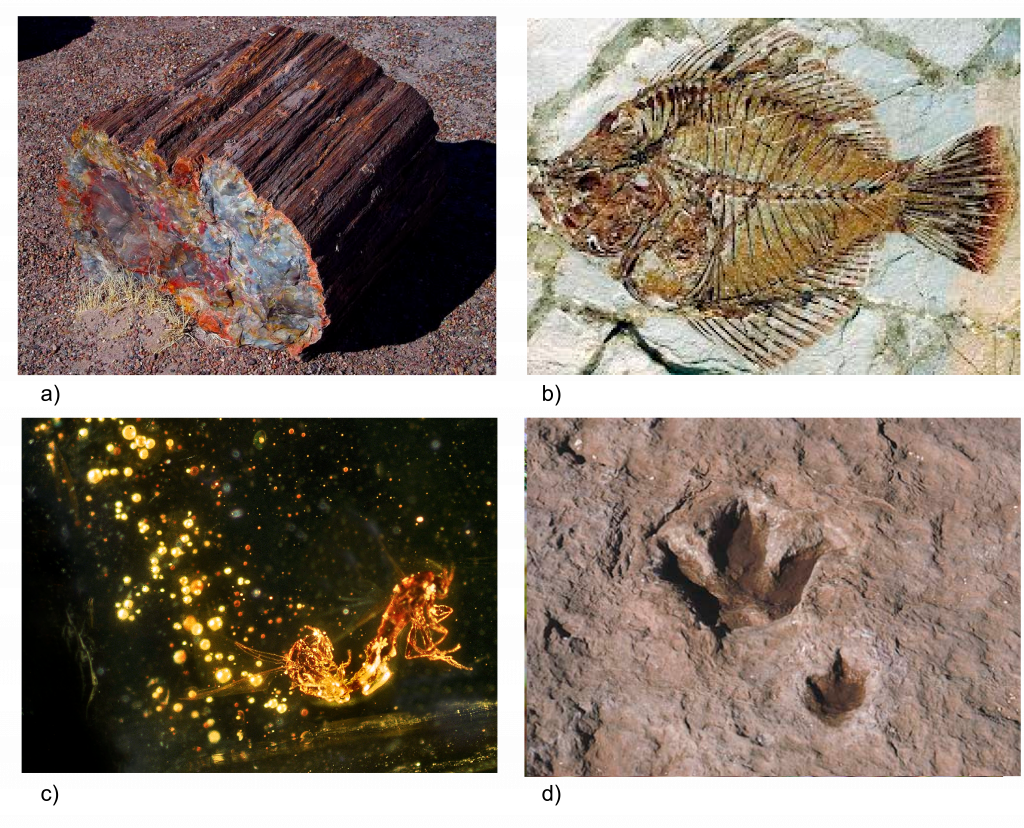2.4 How do we know evolution has occurred? Fossil evidence.
Fossil evidence
Fossils are the preserved remains or traces of organisms that lived in the remote past (over 10,000 years ago). There are many different types of fossils that occur in various steps of completeness, collectively forming the fossil record, which provides a wealth of information about evolution:

- Some fossils are mineralized remains that result from a process in which living tissues are replaced by minerals such as quartz, calcite, and silica. In some cases, a near-perfect representative of an organism is captured in stone—this is called petrifaction. Petrified wood looks a lot like a tree trunk or branch, but if you touch it or kick it, you’ll find out quickly that it’s made of stone. We have learned a lot from petrified wood; for example, the discovery of fossilized tree trunks and leaves in Antarctica suggest the icy landscape was once covered by lush green forests.
- The remains of some organisms are only evident as casts or molds. Molds are impressions left by organisms, whereas casts represent molds that have been filled in by mineralization. In particular, sedimentary rock, which is formed by years of sand accumulating in layers on ancient sea floors, is an excellent source of fossil remains of aquatic organisms. For example, recent discoveries of fish casts have clarified some details about flatfish evolution. Flatfish, such as flounders, have eyes on one side of their heads, posing the question: how did such a body plan evolve? In the past several years, many examples of ancient fish with “transitional” eye arrangements have been discovered; specifically, these fish had eyes that were arranged intermediate to those of flounders and typical bony fish.
- Some organisms persist long after death as unaltered remains. Unaltered remains have changed little since they died, and include hard, decay-resistant tissues such as teeth or shells. Soft tissues can also persist for thousands of years if they have been protected from heat or oxygen (both of which cause decay). Unaltered remains are typically found in ice, amber, or tar deposits. In 2012, an international team of scientists discovered two new species of small insects perfectly preserved in amber (fossilized tree resin) from over 100 million years ago. The discovery of these insects, called thrips, is exciting by itself, but the thrips also carried tiny pollen grains on their wings and abdomens. This is the oldest known evidence of pollination, whereby an animal carries a plant’s sperm (as pollen grains) to eggs. This is also the first example of pollination from the era of the dinosaurs.
- Trace remains are fossilized evidence of living organisms, but not the actual organisms themselves. Examples of trace remains include footprints preserved in rock, mineralized feces (or coprolites), and the molds of once-inhabited burrows. The recent discovery of reptile footprints, in a location that would have been hundreds of miles from the sea, suggests that reptiles have been able to move into continental interiors for at least 318 million years. This discovery pushed back earlier estimates for the movement of reptiles away from the sea by several million years.
Consider the following question
What are some possible limitations of fossilized evidence?

